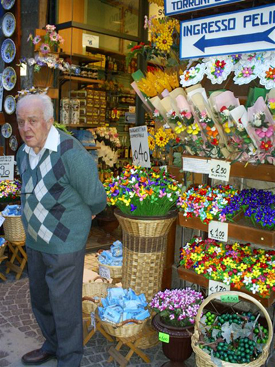|

A shopkeeper sells confetti candy in the town of
Sulmona
Land of 1,000 Castles:
The “Ooh” in Abruzzo
(continued)
By Linda Oatman High
American immigration was the dream for many people of this region,
and those who remained are touched to see Americans immigrating on vacation
to Abruzzo. Madonna's not the only celebrity with Abruzzi roots. There's
Alan Alda and Perry Como, Penny Marshall and James Darren, Henry Mancini
and Rocky Marciano and Al Martino. They've done their homeland proud,
and so have those who remained. There's a sense of pride in the residents,
a strong work ethic and a dedication to open-mindedness, a core value
of community and family and food and wine. These people seem to have
a deep respect for life and for the passing of time, and they want to
savor and enjoy every moment, every meal, every meeting with a stranger
from a far land.
Abruzzo is an amazing and geographically unusual place. Within an hour
or so, one can drive from the highest of mountains peaks to the greenest
of seas, making obsolete the age-old vacation question: beach or mountains?
There are four national parks here, and more than a thousand castles.
There are shepherds herding sheep, and craftspeople painting brilliant
ceramic plates made from the clay of the land.
Here, too, there are eagles and wolves and bear. Three cubs were born
during my visit, and the baby bears made the front-page news.
In Abruzzo it's rare to wait in lines. I didn't see one turnstile or
expensive ticket to be purchased in this place, one of the least populated
in Italy and the greenest in Europe. The towns are the quintessential
Italian villages: narrow winding streets of old stone, steep walks,
villas with laundry drying on balconies and flowers lovingly tended
by those living inside. There's the smell of wood smoke and garlic,
olive oil and wine, sauce simmering on the stove. There's also the interesting
juxtaposition of modern and ancient. I saw a Fisher-Price playhouse
in the backyard of an castle, and a big-screen TV flickering within
a darkened villa apartment.
State-of-the-art is no stranger to those who live in this place, but
still, they preserve what came before. Ernest Hemingway is quoted as
saying there's nothing better than Abruzzo in the fall. Yet, I can't
imagine anything better than Abruzzo in April. It's all good.
A comfortable central place to stay in Abruzzo is the Sporting Hotel
Villa Maria. The rooms are clean, there's a view of the sea, and the
spa is incredible. Who has time for a massage or a facial, though, when
there's a wonderland to discover?
Exploring Abruzzo is like going on an enormous treasure hunt with gasp-inducing
surprises around every curve. The "ooh" factor is huge here,
as big as the sweeping panoramic views of mountains and valleys and
water. There's the fortress in Civitella del Tronto, with its battering
ram and tiny flowers growing through concrete in dark rooms, the restaurant
at the Hotel Zunica, the castle in Capestrano, the snake-catchers in
Cocullo (their festival is the first Thursday in May), the lace-makers
in Guardiagrele. There's the dazzling confetti candy — almonds
coated with sugar in vivid colors and shaped into bouquets — in
Sulmona. There's the church of the Eucharistic Miracle in Lanciano,
and the incredible meals at the Castello Chiola: a breathtaking medieval
castle towering over the quaint village of Castello.
I visited Castello at twilight, and the space between day and night
was stunning. The sky shone with a phosphorescent dark blue, glowing
as if lit from behind. It looked silky and shimmery, kind of like a
gigantic prom dress spread overhead. The slice of moon was the brightest,
whitest I've ever seen, and a colossal star sparkled just below it.
It's lovely to be under the Tuscan sun, yes, but Italy visitors should
plan time to drive a bit south of Tuscany, because it's just as beautiful
below the Abruzzi moon.
There's an Italian word: solare. It means "the light within."
The entire region of Abruzzo is full of solare, and it infuses the visitors,
too. It can be found in the faces of the locals, in the smooth glow
of the olive oils, in the sheen of the wine, in the hues of the art.
One of the world's best-known Italian red wines — Montepulciano
D'Abruzzo — comes from this place, and so does most of the saffron
you may have while in Italy. Harvested from the hills, the flower stigmas
from which the spice is made must be handpicked, requiring sometimes
a quarter million flowers to make just one pound of spice.
Sugar and spice and everything nice: That's Abruzzo.


|